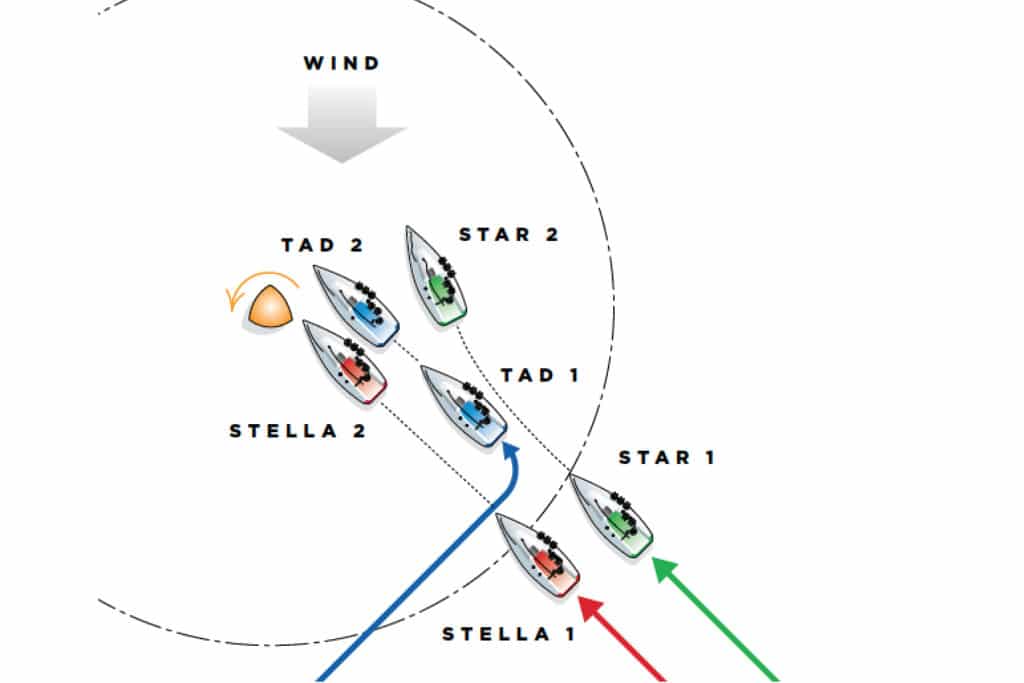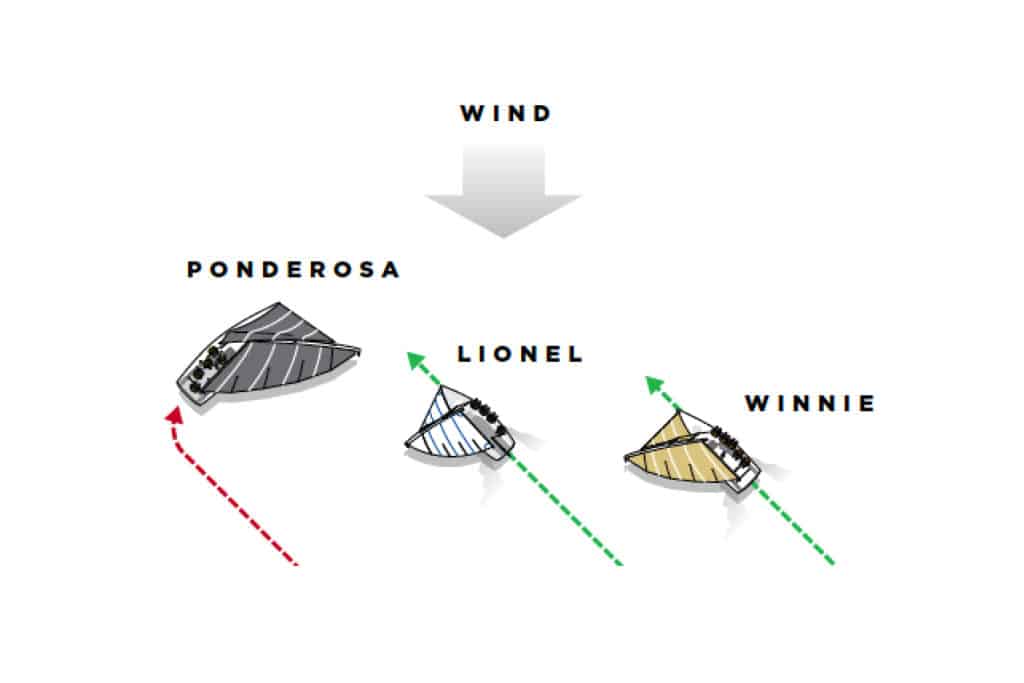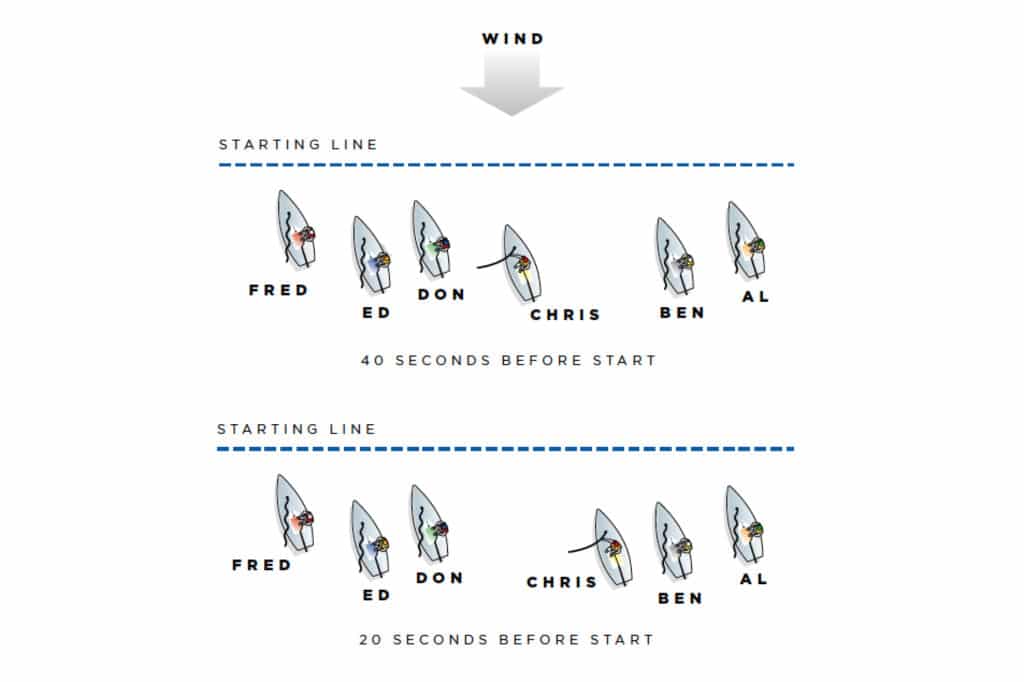
In our third installment of articles covering important rule changes that take effect on January 1, 2017, we explore new Rule 18.3, Tacking in the Zone, which is much simpler and more consistent with the rule’s original intent. Rule 20.1, Hailing for Room to Tack, is now clearer and may save on your repair bills. Finally, Rule 22.3 puts a sensible limit on “crabbing,” a tactic used by dinghies on the starting line.
Rule 18.3: Tacking in the Zone
If a boat in the zone of a mark to be left to port passes head to wind from port to starboard tack and is then fetching the mark, she shall not cause a boat that has been on starboard tack since entering the zone to sail above closehauled to avoid contact, and she shall give mark-room if that boat becomes overlapped inside her. When this rule applies between boats, Rule 18.2 does not apply between them.
Most fleet races require the windward mark to be left to port. The original intent of Rule 18.3 when it was introduced in 1997 was that it should apply only at such a mark. The goals of the original rule were to make it risky to tack from port tack onto starboard within the zone and to offer an advantage to boats that approach the zone on or above the starboard-tack layline. The idea was to encourage orderly roundings of weather marks by discouraging boats from entering the zone on port and tacking ahead or to leeward of a group of starboard-tack boats that were fetching the mark.
The 2016 version of Rule 18.3 applied at windward marks to be left to port, but it also applied when the mark was to be left to starboard, where it served no useful purpose. Also, as World Sailing Case 133 illustrates, it was incredibly complicated to apply the old rule to common three-boat incidents at port-rounding weather marks.
The new rule applies only at a mark to be left to port, and it applies only between a boat that has been on starboard tack since entering the zone and another boat that tacks from port tack to starboard in the zone and is then fetching the mark. Diagram A shows a three-boat situation in which both of Rule 18.3’s requirements are illustrated. Tad enters the zone on port, crosses ahead of two starboard boats, Stella and Star, and then tacks onto starboard tack on a course that will allow him to fetch the mark.
Study the wording of the new rule, and you’ll see that it applies between Tad and Stella and also between Tad and Star. Tad loses speed as a result of his tack. Stella maintains her speed and course and becomes overlapped inside Tad. Soon after Tad tacks, Star finds she must change course to avoid running into Tad’s stern. Because Star would break Rule 11 if she bore off and forced Stella to change course, Star must luff above closehauled to avoid breaking Rule 11 with respect to Stella or Rule 12 with respect to Tad.
Tad is toast. He has broken new Rule 18.3 with respect to Stella because he fails to give her mark-room. To add insult to injury, he has broken Rule 18.3 a second time by causing Star to sail above closehauled. Luckily, he gets only one DSQ despite having fouled two boats.

Rule 20.1: Hailing for Room to Tack
A boat may hail for room to tack and avoid a boat on the same tack. However, she shall not hail unless (a) she is approaching an obstruction and will soon need to make a substantial course change to avoid it safely, and (b) she is sailing closehauled or above.
In addition, she shall not hail if the obstruction is a mark and a boat that is fetching it would be required to change course as a result.
Diagram B shows a three-boat situation that can occur on a beat to windward. In a PHRF race, Lionel and Winnie are sailing keelboats with overlapping genoas set. They are on starboard tack. The wind is at the top of the range for the use of genoas. Ponderosa, a large, heavy full-keel boat sailed by an inexperienced crew, tacks from starboard to port, but her port genoa sheet jams in its block. This puts Ponderosa on port tack, with her genoa aback and almost no speed — right in Lionel’s path. Lionel is trapped. It’s too late for him to bear off without risk of T-boning Ponderosa, and he cannot tack without risk of a serious collision with Winnie. So he hails Winnie for room to tack. Winnie tacks to let Lionel escape, but she protests him for breaking Rule 20.1(a).
Let’s compare how the old and the new Rule 20 apply here. Applying the second-to-last sentence of the definition Obstruction, Ponderosa is not an obstruction to Lionel and Winnie unless both of them are required to keep clear of her. In this situation, however, it is Ponderosa that is required by Rule 10 to keep clear of both Lionel and Winnie. So there is no obstruction present.
Under last year’s version of Rule 20.1, because Lionel and Winnie are not approaching an obstruction, Rule 20 does not apply when Lionel hails, and Winnie is under no obligation to give him room to tack. Under the new Rule 20.1, however, Rule 20 is switched on by a hail for room to tack, even if the hailing boat is not approaching an obstruction. Under the new rule, when Lionel hails, he breaks Rule 20.1(a), but Rule 20.2(b) requires Winnie to respond to his hail even though he has broken Rule 20.1(a). The new Rule 20 provides a safer result. Winnie must give Lionel room to tack (see Rules 20.2[b] and [c]), and the three boats will survive the incident without damage. In the protest room, Ponderosa will be disqualified for breaking Rule 10, and Lionel will be found to have broken Rule 20.1(a), but he will be exonerated under Rule 64.1(a) because he was compelled to break Rule 20.1(a) by Ponderosa’s breach of Rule 10.

Rule 22.3: Limits Crabbing
A boat moving astern, or sideways to windward, through the water by backing a sail shall keep clear of one that is not.
Top-level dinghy sailors have developed a technique called “crabbing.” Diagram C illustrates this technique and how it is used. A fleet of Lasers, all with their sail luffing, are on starboard tack below the starting line, creeping forward, almost stopped. With 40 seconds to go, Chris would prefer to be farther to windward, under Ben, so he can have space to leeward in which to bear off and accelerate in the final few seconds. Chris can move toward Ben by backing his sail and crabbing sideways to windward. Crabbing requires skilled steering, and great care must be taken not to break Rule 42 by sculling.
Rule 22.3 has been changed by adding the phrase “or sideways to windward.” Under last year’s Rule 22.3, Chris retained right of way as the leeward boat while crabbing toward Ben. This put Ben and Al in a difficult position. To keep clear of Chris, Ben, if he knew how to crab, would have to crab toward Al. But Al could not crab to windward, because the space between Al and Ben is not sufficient to enable Al to back his sail and crab.
The new rule still allows Chris to crab to move closer to Ben. However, while Chris is moving “sideways to windward … by backing a sail,” he is now required to keep clear of Ben. The new rule permits Chris to move to windward in the gap under Ben, but Chris must cease crabbing before Ben needs to take avoiding action (see the definition Keep Clear).
The new rule permits the skillful use of crabbing at the start, but limits its use so a crabbing boat does not put a boat to windward of her in an impossible position.
Email for Dick Rose may be sent to rules@sailingworld.com.









